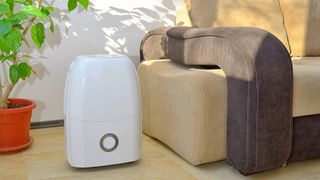How do dehumidifiers work?
How do dehumidifiers work? We get into the science behind these appliances

If you’re thinking of purchasing a dehumidifier, you may be wondering, ‘how do dehumidifiers work?’ While the humidifiers add moisture to the air when it’s too dry, dehumidifiers remove moisture from the air when it’s too humid, making these little beauties great if you live in a hot climate or just want a more comfortable living environment during the spring and summer.
We’ve all experienced humidity of some degree or another. That weighted feeling in the air usually comes from heat, rain or fog and can really affect how we feel as we go about the day. When this happens, it can feel stuffy and even smell like must, which can bring on a series of issues for both you and your home. This is where using the best dehumidifiers come in, and it’s worthwhile to learn about and explore how a dehumidifier can benefit you.
In this article, we’ll discuss what dehumidifiers are and answer a common question, how do dehumidifiers work? We’ll go over the benefits of using a dehumidifier and, finally, we’ll also provide an idea of how much energy it takes to run these units and what that might cost you.
How do dehumidifiers work?
According to the National Asthma Council, dehumidifiers change a room’s humidity level to a relative humidity of 30-50% by taking excess moisture out of the air. When this happens, mold, dust mites, and other allergens are less likely to survive.
A dehumidistat detects the moisture level in the air and powers the unit on when necessary.
Refrigerant-based dehumidifiers are the most popular style of dehumidifiers. They are typically made up of four parts:
- Fan compressor that expands and contracts a refrigerant gas (like freon) to cool down the coils
- Reheater that collects heat generated by the cooling process
- Refrigerated or cooled coils that take moisture from the air through condensation
- Collection tank or tray that collects moisture from the cooled coils
Like a vacuum using a fan, dehumidifiers pass air over their refrigerated coils. This process is similar to how an air conditioning unit works and makes the moisture condense on the unit’s coils. The warm air contracts and loses the moisture it can no longer hold as it moves through the cool coils. This is when it creates condensation, which accumulates inside the dehumidifier’s storage tank or tray.Then, through its other side, the dehumidifier sends the air back into the room over a warm coil.
Do dehumidifiers really work?
Dehumidifiers can offer the following benefits:
- Air quality improvement with reduced humidity
- Mold prevention
- Dust elimination
- Personal comfort
- Lower energy costs
- Protection of your home
For those of you wondering ‘do dehumidifiers help with allergies?’, the answer is yes. By reducing the humidity in your home, you can also help to reduce asthma symptoms and irritation. If you’re going to invest in a dehumidifier, you want to make sure you’re getting all of the benefits that it has to offer. The good news is there’s a way to know whether a dehumidifier is really working for you.

Measuring a dehumidifier’s effectiveness
According to the Code of Federal Regulations of the United States of America, there are two things that indicate how well a dehumidifier is working and functioning.
- Efficiency. You’ll need to assess how efficient a dehumidifier is (its “energy factor”) to know how well it’s working for you. Find this by dividing the amount of water it removes by how much power it consumes. This value is measured in liters or pints per kilowatt-hour (L/kWh).
- Water removed per day. The amount of water a dehumidifier removes in a continuous 24-hour period of use (in liters or pints) clearly indicates how well the unit is working. Larger dehumidifiers, of course, remove more water than their smaller counterparts.
Wattage is also important to consider. Though it won’t indicate the quality of a dehumidifier, higher wattage typically means it works harder and removes more water each hour. For example:
- A small table-top unit takes about 20 watts to operate, takes away about 0.25 liters of water a day, and has a tank that holds about 500 ml.
- A large dehumidifier removes about 50 liters of water a day and uses 1,000 watts or so.
However, you need to consider these figures together and then compare the two units to assess their merit - the wattage on its own can’t give you that.
The small unit will take about four days to remove one liter or 200 days to remove 50 liters, which will use about 96kWh (200 days x 24 hours x 0.02 kW). The large unit will take about one day to remove 50 liters, which will use about 24kWh. So, in this example, the large unit is four times more efficient and 200 times faster than its small counterpart. You can read our article on how big of a dehumidifier do I need to see what size is best for your needs.
If you struggle with damp, check out our guide to what causes dampness in a house.
Finding the right dehumidifier
As with any type of product, some dehumidifiers work well and do what they say they will do, while some leave a lot to be desired. There are some key things you can do when shopping around for a dehumidifier.
First, talk to the sales staff of retailers that sell the units - you will probably get a more objective opinion from those not affiliated with a specific manufacturer. You could also find out about return policies for models you’re interested in. This way, you can potentially take them home, try them out to see if they do what they claim to and, if not, return them.
Finally, look for and assess credible reviews, while paying close attention to what users say about the features most important to you.
Have a look at our guide to are dehumidifiers good for asthma to see if a dehumidifier may help with your asthma symptoms. If you don't think a dehumidifier is quite right for you, you can also have a look at our guide to the best air purifiers to see if an air purifier may suit your needs.

Do dehumidifiers use a lot of electricity?
With all of the benefits dehumidifiers offer, energy efficiency is not one of them. While they don’t take up as much energy as an air conditioning unit which could be 300 kWh monthly, they do consume more than a standard refrigerator. Of course, like any appliance, the amount of energy a dehumidifier requires will vary by type, size and model. They average out at around 280 watts (to compare, computers typically use about 360 watts).
To save energy consumption and money on your bill each month, check out dehumidifier models that meet or exceed the Energy Star requirements. The higher a model’s Energy Factor (EF) number is, the more water it removes per kWh of electricity it consumes. And, the larger the unit, the more impact on energy use and cost a higher-efficiency rating will have.
Here’s an example from Learn Metrics of how much it could cost you to run an energy-efficient (EF of 2.0) vs. energy-inefficient (EF of 1.0) dehumidifier in your home. In this case, assume a cost of 13 cents per kWh, with both units holding 70 pints and running for 1,000 hours. The efficient EF 2.0 unit would cost about $90 per year to run, while the inefficient EF 1.0 unit would cost about twice as much.
Making sure you clean and properly maintain your dehumidifier can also help you save on energy costs. Check out our guide for how to clean a dehumidifier for more information. And, if you’re hoping to save energy costs overall, there is a nice side effect of using a dehumidifier at home: you might feel cooler and, in turn, reduce your energy consumption and costs. This is because we tend to feel warmer in higher humidity. So, when your space is less humid, you may not feel the need for fans or air conditioning as often.
References
The Code of Federal Regulations of the United States of America. (2007, January 1). Google Books. https://books.google.co.uk/books?id=ibE5AAAAIAAJ&printsec=frontcover&source=gbs_ge_summary_r&cad=0#v=onepage&q&f=false
ENERGY STAR. (2022). The Simple Choice for Energy Efficiency. https://www.energystar.gov
Heffernan, T. (2022, April 29). The Best Dehumidifiers. Wirecutter: Reviews for the Real World. https://www.nytimes.com/wirecutter/reviews/best-dehumidifier/
L. (2021, August 12). Dehumidifier Power Efficiency: Do Dehumidifiers Use A Lot Of Electricity? LearnMetrics. https://learnmetrics.com/dehumidifier-energy-efficiency/
The National Asthma Council Australia. (2016, February 16). National Asthma Council Australia. Retrieved April 29, 2022, from https://www.nationalasthma.org.au/news/2016/indoor-humidity
Sign up for the Live Science daily newsletter now
Get the world’s most fascinating discoveries delivered straight to your inbox.
Emma Caplan is a writer and editor with over 10 years of experience in various content types and topics like health and lifestyle, home and design, local events and news, travel, the outdoors, and real estate, business and tech. Emma also edits marketing content as well as fiction and non-fiction books. Her work has been featured in the Chicago Tribune and on Nexstar Media, Narcity Media, and BobVila.com.

